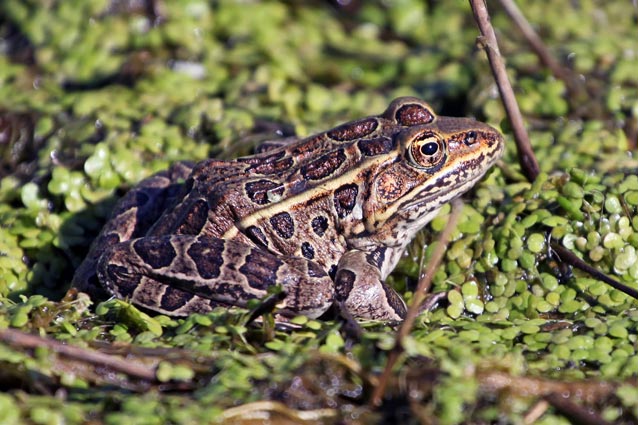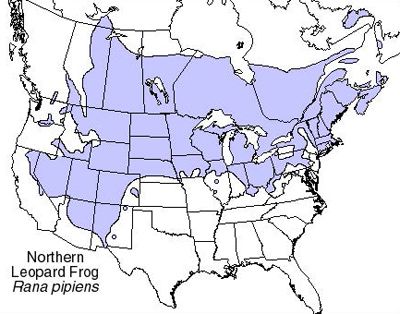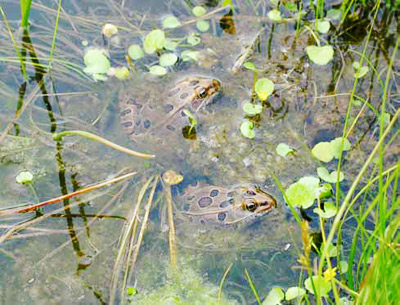Taxonomy
The northern leopard frog (Lithobates pipiens) is in the family Ranidae, the true frogs, and is one of about 29 species of the genus Lithobates (formerly Rana) that occur in North America.
Description

Gary Eslinger / USFWS
The northern leopard frog is a smooth-skinned, green, brown, or sometimes yellow-green frog covered with large, oval dark spots, each of which is surrounded by a lighter halo or border. It has a white to cream-colored underside and distinct, unbroken paler dorsolateral ridges, or fins, along both sides of the back. A large northern leopard frog is about 11.5 cm (4.5 in) in length. Females are slightly larger than the males.
Distribution

Northern Prairie Wildlife Research Center / USGS
Historically, the northern leopard frog was found throughout most of Canada and the U.S., except the southeastern states. Since the 1970s, northern leopard frog populations have declined significantly throughout the species’ range, especially in western Canada and the western U.S. It has been largely extirpated from much of its former habitat in the soutwestern U.S. states.
Habitat Associations
The Northern leopard frog requires a mosaic of aquatic and upland habitats, with linkages between them, to meet the needs of its life stages. Ideally, wetland patches are separated by less than 1 km of upland habitat.
Northern leopard frogs breed in a variety of aquatic habitats, most often in permanent pools, such as the marshy edges and side channels of streams or rivers. However, they also breed in springs, wetlands, beaver ponds, and temporary pools, as well as in human-constructed habitats, such as earthen stock tanks. They lay their eggs in still, permanent water in areas exposed to sunlight, usually attaching the eggs to vegetation just below the surface of the water. Vegetation, like sedges and rushes, is an important habitat feature for emerging tadpoles. In summer, adults and juveniles feed in upland areas adjacent to aquatic and riparian habitats. The frogs commonly feed in open or semi-open wet meadows, and escape from predators in nearby water.
Life History
Sudies show that most adult true frogs will stay within a few kilometers of their breeding place, but some will venture several kilometers away. Newly metamorphized frogs will attempt to disperse from the breeding area, moving along drainages and across dry land. The lifespan of a northern leopard frog is 5-8 years.
Feeding Habits
Adult and juvenile northern leopard frogs eat small invertebrates, spiders, mollusks, and crustaceans. Tadpoles are generalist herbivores, eating algae, plant tissue, organic debris, and probably small invertebrates.
Reproductive Biology

Shaula Hedwall / USFWS
Breeding generally occurs from mid-March through early June, and begins with the male calling the female from a breeding pond. Mating occurs in the water—the female swims around and the male hangs on to her back, holding on with his specialized thumbs. Within 2-3 days, the female lays the eggs—several hundred to several thousand— in an egg mass that measures 7.5-15 cm (3-6 in) across. Release of the eggs stimulates the male to ejaculate, and the eggs are fertilized. Tadpoles hatch in about a week and metamorphose in about three months.
Conservation Status
Over the past thirty years, the northern leopard frog has suffered dramatic declines in the number and health of functioning metapopulations across its western range. A number of factors have contributed to this decline, including habitat loss and degradation; introduction of exotic predators, such as nonnative fish, bullfrogs and crayfish; introduction of disease and pesticides; and climate change effects on aquatic habitats.
In 2006 eight environmental organizations submitted a petition to the U.S. Fish and Wildlife Service (USFWS) to list the western population of the northern leopard frog (in Wisconsin and the states west of the Mississippi River). After an initial review of the petition, the USFWS determined that the northern leopard frog may warrant a listing as a threatened or endangered species, but that it would conduct a comprehensive status review before issuing a final decision.
Currently, the northern leopard frog is considered a species of concern in Arizona, California, Colorado, and New Mexico.
References
Arizona Game and Fish Department. Animal abstract: Rana Pipiens. Heritage Data Management system. Available at http://www.azgfd.gov/w_c/edits/documents/ Ranapipi.fi_001.pdf (accessed 24 May 2010).
Myers, P., R. Espinosa, C. S. Parr, T. Jones, G. S. Hammond, and T. A. Dewey. 2006. The Animal Diversity Web (online). Available at http://animaldiversity.org (accessed 27 May 2010).
National Biological Information Infrastructure. Southwest species of greatest conservation need: Northern leopard frog. Available at http://www.nbii.gov/portal/server.pt ?open=512&objID=1811&PageID=6592&mode=2& in_hi_userid=2&cached=true (accessed 24 May 2010).
Nature Serve. 2009. Rana pipiens. NatureServe Explorer. Version 7.1. NatureServe, Arlington, Virginia. Available http://www.natureserve.org/explorer. (accessed 25 May 2010).
U.S. Fish & Wildlife Service. 2009. Endangered and threatened wildlife and plants; 90-day finding on a petition to list the northern leopard frog (Lithobates [=Rana] pipiens) in the western United States as Threatened. Federal Register 63:31389-31401. available at: http://www.fws. gov/midwest/eco_serv/soc/amphibians/nlfr90day.pdf (accessed 24 May 2010).
U.S. Fish & Wildlife Service, Arizona Ecological Services. 2009. Northern leopard frog in west may warrant federal protection. Available at http://www.fws.gov/southwest/ es/arizona/Documents/SpeciesDocs/NorthernLeopard- Frog/NLF90-day.NR.WO.V2.pdf (accessed 24 May 2010).
U.S. Fish & Wildlife Service, Arizona Ecological Services. Northern leopard frog: General species information. Available at http://www.fws.gov/southwest/es/arizona/ Northern_Frog.htm (accessed 24 May 2010).
Prepared by Jean Palumbo, Southern Colorado Plateau Network Inventory and Monitoring Program, 2010.
Last updated: May 20, 2015
